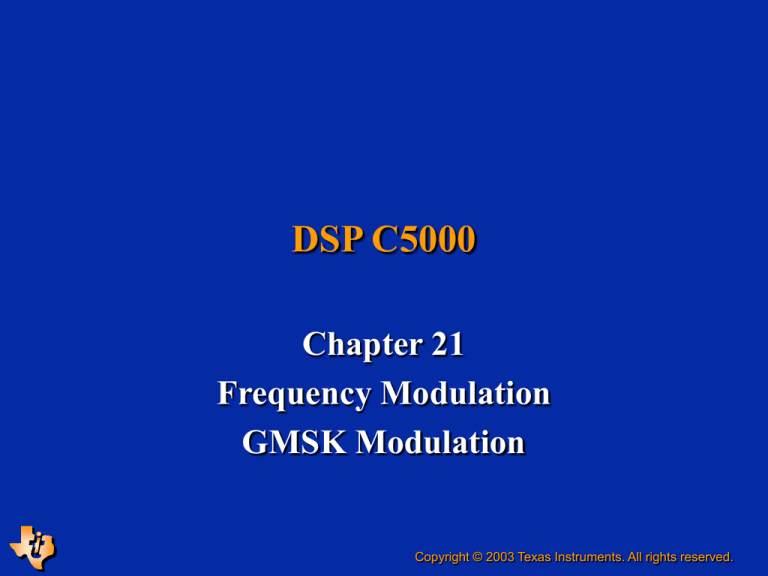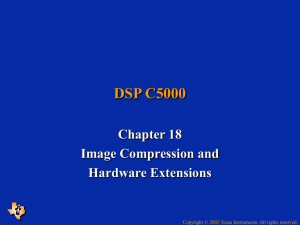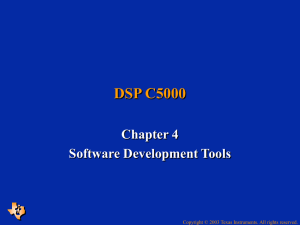
DSP C5000
Chapter 21
Frequency Modulation
GMSK Modulation
Copyright © 2003 Texas Instruments. All rights reserved.
Learning Objectives
ESIEE, Slide 2
Overview of Digital Modulation
Understanding GMSK Modulation
Learning how to Implement a GMSK
Modulator on a C54
Copyright © 2003 Texas Instruments. All rights reserved.
Digital Modulations
Baseband and bandpass signalling are used to
transmit data on physical channels such as
telephone cables or radiofrequency channels.
The source of data (bits or symbol) may be a
computer file or a digitized waveform (speech,
video…)
The transmitted signal carries information about
the data and its characteristic changes at the same
rate as the data.
When the signal carrying the data information
Extends from 0 Hz upwards, the term baseband
signalling is used.
Has its power centered on a central frequency fc,
the term bandpass signalling or modulation is
used.
ESIEE, Slide 3
Copyright © 2003 Texas Instruments. All rights reserved.
Digital Modulation
Modulation is used because:
ESIEE, Slide 4
The channel does not include the 0 Hz
frequency and baseband signalling is
impossible
The bandwidth of the channel is split
between several channels for frequency
multiplexing
For wireless radio-communications, the
size of the antenna decreases when the
transmitted frequency increases.
Copyright © 2003 Texas Instruments. All rights reserved.
Carrier Frequency
In simple modulation schemes, a single
frequency signal, the carrier, is modified
at the rate of the data.
The carrier is commonly written as:
A cos 2 f c t
ESIEE, Slide 5
fc= Carrier frequency
A = Carrier Amplitude
= Carrier phase
The 3 main parameters of the carrier:
amplitude, phase and frequency can be
modified to carry the information
leading to: amplitude, phase and
frequency modulation.
Copyright © 2003 Texas Instruments. All rights reserved.
Digital Modulation
CPM: Continuous Phase Modulation
QAM: Quadrature Amplitude Modulation
Example: QPSK, OQPSK, 16QAM
Characteristic: High spectral efficiency
Multicarrier Modulation
ESIEE, Slide 6
Frequency or phase modulation
Example: MSK, GMSK
Characteristic: constant envelope modulation
Example: OFDM, DMT
Characteristic: Muti-path delay spread tolerance,
effectivness against channel distortion
Copyright © 2003 Texas Instruments. All rights reserved.
What is the Complex Envelope z(t) of a
Modulated Signal x(t) ?
x ( t ) z ( t ) e j 2 f c t z I ( t )cos 2 f c t z Q ( t ) sin 2 f c t .
fc= Carrier frequency
z ( t ) x ( t ) jx H ( t ) e
j 2 fct
z I ( t ) jz Q ( t ) A ( t ) e
j ( t )
z(t) = Complex envelope of x(t)
zI(t), zQ(t) are the baseband components
xH(t) = Hilbert transform of x(t) = x(t) with a phase shift of /2
S x ( f ) 1 S z ( f f c ) S z ( f f c ) .
2
Sx(f) = Power spectral density of x(t)
ESIEE, Slide 7
Copyright © 2003 Texas Instruments. All rights reserved.
Complex Envelope z of a Modulated Signal x
Frequency Domain
2
X (f)
1
1
f
0
2
X a (f)
2
1
f
0
2
Z (f)
2
1
f
0
ESIEE, Slide 8
Copyright © 2003 Texas Instruments. All rights reserved.
GMSK Modulation
Gaussian Minimum Shift Keying.
Used in GSM and DECT standards.
Relevant to mobile communications
because of constant envelope
modulation:
ESIEE, Slide 9
Quite insensitive to non-linearities of power
amplifier
Robust to fading effects
But moderate spectral efficiency.
Copyright © 2003 Texas Instruments. All rights reserved.
What is GMSK Modulation?
Continuous phase digital frequency
modulation
Modulation index h=1/2
Gaussian Frequency Shaping Filter
GMSK = MSK + Gaussian filter
Characterized by the value of BT
ESIEE, Slide 10
T = bit duration
B = 3dB Bandwidth of the shaping filter
BT = 0.3 for GSM
BT = 0.5 for DECT
Copyright © 2003 Texas Instruments. All rights reserved.
GMSK Modulation, Expression for the
Modulated Signal x(t)
x ( t ) cos 2 f c t ( t ) w ith:
t
( t ) 2 h
a k s ( kT ) d
k
ak = Binary data = +/- 1
h = Modulation index = 0.5
Normalization
s(t) = Gaussian frequency shaping filter
s(t)= Elementary frequency pulse
s ( ) d
ESIEE, Slide 11
1
2
Copyright © 2003 Texas Instruments. All rights reserved.
GMSK Elementary Phase Pulse
t
q (t )
s ( ) d .
E lem entary phase pulse = ( t )
t
( t ) 2 hq ( t ) 2 h
s ( ) d .
For t nT , ( n 1)T
n
( t ) 2 h
n
a k q ( t kT )
k
x ( t ) cos 2 f c t ( t ) cos 2 f c t
ESIEE, Slide 12
a k ( t kT )
k
a
(
t
kT
)
k
.
k
n
Copyright © 2003 Texas Instruments. All rights reserved.
Architecture of a GMSK Modulator
G M S K m o d u lato r u sin g a V C O
a
k
t kT
a s t kT
k
k
k
C o d er
r (t )
x(t )
VCO
h(t )
B its ak
h
s (t ) r (t ) * h (t )
R ectan g u lar filter G au ssian filter
G M S K m o d u lato r w ith o u t V C O
co s 2 f c t
co s()
2h
a t kT
k
k
t
C od er
s(t )
B its a k
s( t ) r ( t ) * h ( t )
ESIEE, Slide 13
(t)
sin 2 f c t
+
x (t)
sin ()
Copyright © 2003 Texas Instruments. All rights reserved.
Equation for the Gaussian Filter h(t)
h (t )
2 2 B 2 2
B exp
t
ln(2)
ln(2)
2
ln(2) 2
H ( f ) exp
f
2
2B
The duration MTb of the gaussian pulse
is truncated to a value inversely
proportional to B.
BT = 0.5, MTb = 2Tb
BT = 0.3, MTb = 3 or 4Tb
ESIEE, Slide 14
Copyright © 2003 Texas Instruments. All rights reserved.
Frequency and Phase Elementary Pulses
Tbg(t )
Elementary frequency pulse
BTb
0.5
BTb 05
,
BTb 03
,
0.4
0.3
(t )
Elementary phase pulse
1.6
/2
BT b
1.4
1.2
BT
b
1
BT
b
0 .5
0 .3
0.8
0.6
0.2
0.4
0.1
0
0.2
0
-2
-1
0
1
2
t in number of bit periods Tb
-2
-1
0
1
2
t in number of bit period Tb
The elementary frequency pulse is
the convolution of a square pulse
r(t) with a gaussian pulse h(t).
Its duration is (M+1)Tb.
ESIEE, Slide 15
Copyright © 2003 Texas Instruments. All rights reserved.
GMSK Signals
1
Binary sequence
t
0
-1
0
5
10
15
20
1
t
GMSK modulated Signal 0
-1
(t )
0
5
10
15
20
5
t
0
in rd
-5
z I ( t ) cos ( t )
1
0
5
10
15
20
t
0
-1
0
5
10
15
20
1
z Q ( t ) sin ( t ) 0
-1
ESIEE, Slide 16
t
0
5
10
15
20
Copyright © 2003 Texas Instruments. All rights reserved.
Power Spectral Density of GMSK Signals
P o w er sp ectral d en sity o f th e co m p lex en v elo p e o f G M S K , B T = 0 .3 , fe= 8 , T = 1 .
L o garith m ic scale
20
0
-2 0
-4 0
-6 0
-8 0
-1 0 0
-1 2 0
-1 4 0
0
ESIEE, Slide 17
0 .5
1
1 .5
2
2 .5
3
F req u en cy n o rm aliz ed b y 1 /T
3 .5
4
Copyright © 2003 Texas Instruments. All rights reserved.
Implementing a GMSK Modulator on a DSP
Quadrature modulation can be used:
The DSP calculates the phase and the 2
baseband components zI and zQ and sends
them to the DAC.
Or a modulated loop can be used.
In this case, the DSP generates the
instantaneous frequency finst signal that is
sent to the DAC.
f in st h
a k s ( kT ).
k
ESIEE, Slide 18
Copyright © 2003 Texas Instruments. All rights reserved.
Calculation of the Instantaneous Frequency
finst is obtained by a simple filtering of
the bit sequence ak by a FIR filter of
impulse response s(n).
Open Matlab routine
pul_phas.m to calculate s(n).
Explanation of parameters are
given in following slides.
ESIEE, Slide 19
Copyright © 2003 Texas Instruments. All rights reserved.
Expression for the Baseband Components
The baseband components zI and zQ are
modulated in amplitude by the 2
quadrature carriers.
x ( t ) cos 2 f c t ( t ) cos ( t ) cos 2 f c t sin ( t ) sin 2 f c t
x ( t ) z I ( t ) cos 2 f c t z Q ( t ) sin 2 f c t
ESIEE, Slide 20
Copyright © 2003 Texas Instruments. All rights reserved.
Baseband Components and Carriers
Baseband components
z I ( t ) cos ( t )
z Q ( t ) sin ( t )
The carriers are generally RF analog
signals generated by analog oscillators
However, we will show how they could
be generated digitally if the value of fc
were not too high.
C arrierI cos 2 f c t
C arrierQ sin 2 f c t
ESIEE, Slide 21
Copyright © 2003 Texas Instruments. All rights reserved.
Calculation of the Baseband
Components on a DSP
Calculate the phase at time mTS
Ts the sampling frequency.
Read the value of cos() and sin()
from a table.
For t nT , ( n 1)T
n
(t )
a k ( t kT ).
k
n
( m TS )
a k ( m T S kT ).
k
ESIEE, Slide 22
Copyright © 2003 Texas Instruments. All rights reserved.
Calculation of the Elementary Pulse Phase
with Matlab
The elementary pulse phase (mTS) is
calculated with Matlab and stored in
memory.
The duration LT of the evolutive part of
(mTS) depends on the value of BT.
is called phi in the matlab routine.
t
( t ) 2 h
s ( ) d
(t ) 0 t 0
( t ) h t L T
ESIEE, Slide 23
Copyright © 2003 Texas Instruments. All rights reserved.
Calculation of the Elementary Pulse Phase
with Matlab 1/2
Beginning of the matlab routine
function [phi,s]= pul_phas(T _over_T s,L ,B T ,T )
T s= T / T _over_T s ;
% calculates the num ber of sam ples in phi in the interval 0 - L T
N phi= ceil(T _over_T s*L );
% calculates the num ber of sam ples in T
N ts= ceil(T _over_T s);
Open Matlab
routine
pul_phas.m
phi= zeros(1,N phi);
s= zeros(1,N phi);
sigm a= sqrt(log(2))/2/pi/(B T /T )
ESIEE, Slide 24
Copyright © 2003 Texas Instruments. All rights reserved.
Calculation of the Elementary Pulse Phase
with Matlab 2/2
End of the matlab routine
t= [-L * T /2 :T s:L * T /2 ];
t= t(1 :N ph i);
ta= t+ T /2 ;
tb = t-T /2 ;
Q ta= 0.5*(on es(1,N ph i)+ erf(ta/sig m a/sqrt(2)));
Q tb= 0.5*(on es(1,N ph i)+ erf(tb /sig m a/sqrt(2)));
exp ta= exp (-0 .5 *((ta/sigm a).^2 ))/sq rt(2* p i)* sig m a;
exp tb = exp (-0 .5 *((tb /sigm a).^2 ))/sq rt(2* p i)* sig m a;
p h i= p i/T /2 *(ta.*Q ta+ ex p ta -tb .* Q tb -ex p tb );
s= 1 /2 /T *(Q ta -Q tb);
ESIEE, Slide 25
Copyright © 2003 Texas Instruments. All rights reserved.
Using the Matlab Routine
Start Matlab
Use:
call the routine using to calculate the
phase pulse phi ( ) and the pulse s:
[phi,s]=pul_phas(T_over_Ts,L,BT,T)
Plot the phase phi and the shaping pulse s
ESIEE, Slide 26
T_over_Ts=8
L=4
T=1
BT=0.3
plot(phi)
plot(s)
Copyright © 2003 Texas Instruments. All rights reserved.
Results of Matlab Routine
ESIEE, Slide 27
Copyright © 2003 Texas Instruments. All rights reserved.
Results for phi
For L=4 and T_over_Ts=8, we obtain 32
samples for phi. Matlab gives the
following values for phi:
Phi=
[0.0001,
0.0062, 0.0127,
0.1884, 0.2740,
0.9299, 1.0672,
1.4945, 1.5262,
1.5696, 1.5703,
After this evolutive part of phi, phi stays
equal to /2 (1.57).
To calculate , the evolutive part and
the constant part of the elementary
phase pulse phi are treated separately.
ESIEE, Slide 28
0.0002, 0.0005,
0.0246, 0.0446,
0.3798, 0.5036,
1.1910, 1.2968,
1.5462, 1.5581,
1.5706]
0.0012,
0.0763,
0.6409,
1.3824,
1.5646,
0.0028,
0.1231,
0.7854,
1.4476,
1.5680,
Copyright © 2003 Texas Instruments. All rights reserved.
Calculation of
Separation of evolutive and constant
parts of phi.
F o r t n T , ( n 1)T
nL
n
(t )
a k ( t kT )
k
k
n
a k ( t kT )
a k ( t kT ) w ith :
k n L 1
(t ) 0 t 0
( t ) h
h
t LT
2
(t )
2
ESIEE, Slide 29
n L
k
n
ak
k n L 1
n
a k ( t kT ) p h im em ( n )
a k ( t kT )
k n L 1
Copyright © 2003 Texas Instruments. All rights reserved.
Memory Part and Evolutive Part of
For t nT , ( n 1)T
phim em ( n ) phim em ( n 1) a ( n L )
.
2
n
( t ) phim em ( n )
a k ( t kT )
k n L 1
t m TS
n
( m T S ) phim em ( n )
a k ( m T S kT )
k n L 1
ESIEE, Slide 30
Copyright © 2003 Texas Instruments. All rights reserved.
Recursive Calculation of
Names of variables
Phase =
phi = array of evolutive part of ,
Ns = number of samples per bit = T/Ts
an = binary sequence (+/- 1)
2 calculation steps:
ESIEE, Slide 31
Nphi samples = LT/Ts
Calculate
Calculate zI=cos() and zQ=sin() by table
reading
Copyright © 2003 Texas Instruments. All rights reserved.
Calculation of : Initialization
Initialization step:
L first bit periods, phimem = 0
At bit L+1, phimem is set to a1 /2.
Principle of the initialization processing:
FOR i=1 to i=L
for j=(i-1)Ns+1 to j=(i-1)Ns+Nphi
ESIEE, Slide 32
phase((i-1)Ns+j)= phase((i-1)Ns+j)+phi(j)an(i)
Endfor
endFOR
phimem=an(1) /2
Copyright © 2003 Texas Instruments. All rights reserved.
Calculation of : After Initialization
FOR i=L+1 to last_bit
For j=(i-1)Ns+1 to j=(i-1)Ns+Nphi
endFor
For j=(i-1)Ns+1 to j=i Ns
ESIEE, Slide 33
phase((i-1)Ns+j)= phase((i-1)Ns+j)+phi(j)an(i)
phase((i-1)Ns+j)= phase((i-1)Ns+j)+phimem
xi=cos(phase(i-1)Ns+j)
xq=sin(phase((i-1)Ns+j)
endFor
phimem=phimem+pi/2 an(i+1-L)
endFOR
Copyright © 2003 Texas Instruments. All rights reserved.
Coding and Wrapping the Phase Table
The phase value in [-,[ is represented
by the 16-bit number Iphase
Minimum phase = -, Iphase = -215.
Maximum phase = (1-215), Iphase = 215-1.
15
Iphase
ESIEE, Slide 34
2 phase
Copyright © 2003 Texas Instruments. All rights reserved.
Index for the table in Phase Calculation
Phase increment between 2 table values:
2 / Ncos and on Iphase 216/Ncos
For Iphase, the index of the table is:
ESIEE, Slide 35
i= Ncos Iphase 2-16
Here Ncos 2-16 = 2-9,
So the index in the table is given by shifting
Iphase 9 bits to the right.
Copyright © 2003 Texas Instruments. All rights reserved.
Coding of phi
The quantized values of phi can be
obtained with Matlab:
phi
ESIEE, Slide 36
phi= round(phi*2^15/pi);
phi is defined and initialized in the file
phi03.asm as:
.ref phi
.sect "phi"
.word 1,2,5,13,29,65,133,256
.word 465,795,1284,1965,2858,3961,5252,6685
.word 8192,9699,11132,12423,13526,14419,15100,15589
.word 15919,16128,16251,16319,16355,16371,16379,16382
Copyright © 2003 Texas Instruments. All rights reserved.
Calculation of sin() and cos() by
Table Lookup
We use a table of cosine values
Length of the table Ncos=128, circular
buffer
Contents of the table: cosine of angles i
uniformly distributed between - and .
i
ESIEE, Slide 37
i
N
N cos N cos
i
,
1
2
2
deb_cos = first address of the table
mid_cos = address of the table middle
cos(i ) is at address mid_cos + i
Copyright © 2003 Texas Instruments. All rights reserved.
Calculation of sin() and cos() by
Table Lookup
Conversion of the phase modulo 2:
Wrapping phase in [-,[
Done by a macro: testa02pi
* Macro to wrap the phase between
testa02pi
.macro
SUB #8000h,A,B
BC
suite1?, BGEQ
SUB #8000h,A
SUB #8000h,A
B suite?
suite1?
ADD #8000h,A,B
BC
suite?,BLT
ADD #8000h,A
ADD #8000h,A
suite?
.endm
ESIEE, Slide 38
- et , phase is in ACCU A
;
;
;
;
sub -2^(15)
test if phase is in [0,2pi[
sub -2^(15)
SUB -2^(15)
; add -2^(15)
; add -2^(15)
; add -2^(15)
; end of test
Copyright © 2003 Texas Instruments. All rights reserved.
Generating the Sine Values from a Table of
Cosine Values
To generate sin() from the table of
cosine values, we use:
cos(/2 - ) or cos(-/2 + ) or cos(3/2+ )
If i is the index of the cosine, for the sine we
use:
ESIEE, Slide 39
i-Ncos/4
i+3Ncos /4
if i>= -Ncos/4
if i < Ncos/4.
Copyright © 2003 Texas Instruments. All rights reserved.
Implementation on a C54x, Test Sequence
We can test the GMSK modulation on a
given periodical binary sequence an:
an=[ 0 1 1 0 0 1 0 1 0 0]
These bits are stored in a circular buffer:
Size NB = 10
Declaration of a section bits aligned on an
address which is a multiple of 16 bits.
AR5
d eb _b it
NB
an
ESIEE, Slide 40
Copyright © 2003 Texas Instruments. All rights reserved.
Testing the Generation of on the C54x,
Results Buffer
We calculate and store it in a buffer
pointed by AR1. The size of the result
buffer is 1000 words.
resu
AR1
1000
B u ffer for th e last 1000 resu lt valu es of
ESIEE, Slide 41
Copyright © 2003 Texas Instruments. All rights reserved.
Testing the Generation of on the C54x
Buffers
d eb _p h ase
AR3
phi
AR4
Nphi
phi
C ircu lar B u ffer for p h i (evolu tive p art)
A llocated at an ad d ress m u ltip le of 64
(N p h i = 32)
ESIEE, Slide 42
Nphi
p h ase
C ircu lar B u ffer for th e variab le p h ase
A llocated at an ad d ress m u ltip le of 64
(N p h i = 32)
Copyright © 2003 Texas Instruments. All rights reserved.
Listing for the Calculation of
Definitions
Nphi
Nphim
L
Ncos
Nsur2
Nsur4
NB
NS
ESIEE, Slide 43
.mmregs
.global
.global
.global
.global
.set
.set
.set
.set
.set
.set
.set
.set
.bss
debut,boucle
deb_cos, phi
deb_phase
resu
32
-32
4
128
64
32
10
8
resu,1000
Copyright © 2003 Texas Instruments. All rights reserved.
Listing for the Calculation of
Macro for phase wrapping
* Definition of macro of phase wrapping testa02pi
testa02pi .macro
SUB
#8000h,A,B
;sub -2^(15)
BC
suite1?, BGEQ
;test if phase in [0,2pi[
SUB
#8000h,A
;sub -2^(15)
SUB
#8000h,A
;sub -2^(15)
B
suite?
suite1?
ADD #8000h,A,B
;add -2^(15)
BC
suite?,BLT
ADD
#8000h,A
;add -2^(15)
ADD
#8000h,A
;add -2^(15)
suite?
;end test wrapping [0,2pi[
.endm
ESIEE, Slide 44
Copyright © 2003 Texas Instruments. All rights reserved.
Listing for the Calculation of
Initialization of Registers and Buffers 1/2
.text
* Initialization of BK, DP, ACCUs, and ARi
debut: LD
#0, DP
LD
#0, A
LD
#0, B
STM
#deb_bit,AR5
STM
#deb_cos,AR2
STM
#deb_phase ,AR3
STM
#phi,AR4
STM
#resu,AR1
STM
+1,AR0
STM
#Nphi, BK
STM
#(NS-1),AR7
RSBX
OVM
SSBX
SXM
ESIEE, Slide 45
Copyright © 2003 Texas Instruments. All rights reserved.
Listing for the Calculation of
Initialization of Registers and Buffers 2/2
* Initialization of the phase buffer
RPT
#(Nphi-1)
STL
A,*AR3+%
*initialization of phimem
LD
*AR5,T
MPY
#04000h,A ; -2^(14) an(1)(pi/2 an(1))
STL
A,*(phimem)
ESIEE, Slide 46
Copyright © 2003 Texas Instruments. All rights reserved.
Listing for the Calculation of
Calculation for the first L bits
* processing for the first L bits
STM
#(L-1),AR6
Ldeb
STM
#Nphi-1,BRC
RPTB fin-1
LD
*AR3,A
MAC
*AR4+0%,*AR5,A
testa02pi
STL
A,*AR3+%
NOP
fin
NOP
STM
#(NS-1), AR7
Nsbouc
LD
*AR3,A
STL A,*AR1+
ST
#0,*AR3+%
BANZ nsbouc,*AR7STM
MAR
STM
BANZ
ESIEE, Slide 47
; from k=0 to k=Nphi
; accu=phase(k)
; A=phase(k)+an(i) phi(k)
; A->phase(k)
; output of NS values
; and reset at 0 of NS words
#NB, BK
*AR5+%
#Nphi,BK
Ldeb, *AR6-
Copyright © 2003 Texas Instruments. All rights reserved.
Listing for the Calculation of
Calculation of the Following Bits 1/2
* begin of the infinite loop
boucle
STM
#Nphi-1,BRC
RPTB
fin2-1
; for k=0 to Nphi
LD
*AR3,A
; accu=phase(k)
MAC
*AR4+0%,*AR5,A ; A=phase(k)+an(i) phi(k)
testa02pi
STL A,*AR3+%
; A->phase(k)
fin2
* adding phimem to the NS first points of the array
* then taking them out and reset to 0 in phase
STM
#NS-1,AR7
nsbouc2
LD
*(phimem),B
ADD
*AR3,B,A
; B=phimem+phase(k)
testa02pi
STL
A,*AR1+
ST
#0,*AR3+%
; 0->phase(k)
BANZ
nsbouc2,*AR7- ; ....
ESIEE, Slide 48
Copyright © 2003 Texas Instruments. All rights reserved.
Listing for the Calculation of
Calculation of the Following Bits 2/2
fin3
* actualization of phimem
LD
*(phimem),A
STM
#NB, BK
MAR
*+AR5(#unmL)%
LD
*AR5,T
MAC
#04000h,A
; -2^(14) an(1)(pi/2 an(1))
testa02pi
STL
A,*(phimem)
MAR
*+AR5(#L)%
STM
#Nphi,BK
B
boucle
.end
ESIEE, Slide 49
Copyright © 2003 Texas Instruments. All rights reserved.
Illustration of the Phase Result Wrapped
Between - and
ESIEE, Slide 50
Plot under CCS the buffer of phase results
Copyright © 2003 Texas Instruments. All rights reserved.
Generation of the Baseband Components
zI=cos() and zQ=sin()
We calculate zI and zQ and we do not
need to save the phase any more.
We output ZI and Zq, in this example
on DXR0 and DXR1.
We need the table of constants for the
values of cosine.
ESIEE, Slide 51
This table is defined in the file tabcos.asm
The cosine values are given in format Q14.
Copyright © 2003 Texas Instruments. All rights reserved.
File tabcos.asm
deb_cos
mid_cos
ESIEE, Slide 52
.def deb_cos,mid_cos
.sect "tab_cos"
.word -16384,-16364,-16305,-16207,-16069,-15893,-15679,-15426
.word -15137,-14811,-14449,-14053,-13623,-13160,-12665,-12140
.word -11585,-11003,-10394,-9760,-9102,-8423,-7723,-7005
.word -6270,-5520,-4756,-3981,-3196,-2404,-1606,-804
.word 0,804,1606,2404,3196,3981,4756,5520
.word 6270,7005,7723,8423,9102,9760,10394,11003
.word 11585,12140,12665,13160,13623,14053,14449,14811
.word 15137,15426,15679,15893,16069,16207,16305,16364
.word 16384,16364,16305,16207,16069,15893,15679,15426
.word 15137,14811,14449,14053,13623,13160,12665,12140
.word 11585,11003,10394,9760,9102,8423,7723,7005
.word 6270,5520,4756,3981,3196,2404,1606,804
.word 0,-804,-1606,-2404,-3196,-3981,-4756,-5520
.word -6270,-7005,-7723,-8423,-9102,-9760,-10394,-11003
.word -11585,-12140,-12665,-13160,-13623,-14053,-14449,-14811
.word -15137,-15426,-15679,-15893,-16069,-16207,-16305,-16364
.set deb_cos+64
Copyright © 2003 Texas Instruments. All rights reserved.
Listing for the Calculation of zI and zQ
The listing for definitions and
initializations is the same as before.
Processing of the L first bits,
Processing of the other bits
ESIEE, Slide 53
(infinite loop)
Copyright © 2003 Texas Instruments. All rights reserved.
Processing of the First L Bits 1/2
Processing of the L first bits
STM
#(L-1),AR6
Ldeb
STM
#Nphi-1,BRC
RPTB
fin-1
; from k=0 to Nphi
LD
*AR3,A
; accu=phase(k)
MAC
*AR4+0%,*AR5,A
; A=phase(k)+an(i) phi(k)
testa02pi
STL
A,*AR3+%
; A->phase(k)
fin
NOP
STM
#(NS-1), AR7
Nsbouc LD
*AR3,A
; output of NS values
SFTA
A,-9,A
ADD
#mid_cos,A,B
STLM
B,AR1
NOP
NOP
LD
*AR1,B
STL
B,DXR0
*
ESIEE, Slide 54
Copyright © 2003 Texas Instruments. All rights reserved.
Processing of the First L Bits 2/2
* Calculation of the sine
ADD
#Nsur4,A,B
BC
sui,BGT
ADD
#(Nsur2),B
B
sui1
sui
SUB
#Nsur2,B
sui1
ADD
#mid_cos,B
ESIEE, Slide 55
STLM
NOP
NOP
LD
STL
ST
BANZ
B,AR1
STM
MAR
STM
#NB, BK
*AR5+%
#Nphi,BK
*AR1,A
A,DXR1
#0,*AR3+%
nsbouc,*AR7-
Copyright © 2003 Texas Instruments. All rights reserved.
Processing of the Following bits 1 of 2
* begin the infinite loop
boucle
STM
#Nphi-1,BRC
RPTB fin2-1
; for k=0 to Nphi
LD
*AR3,A
; accu=phase(k)
MAC
*AR4+0%,*AR5,A
; A=phase(k)+an(i) phi(k)
testa02pi
STL
A,*AR3+%
; A->phase(k)
fin2
*phimem is added to the NS first points of the array
* then they are output and words are reset to 0 in buffer phase
STM
#NS-1,AR7
nsbouc2
LD
*(phimem),B
ADD
*AR3,B,A
; A=phimem+phase(k)
testa02pi
SFTA A,-9,A
ADD
#mid_cos,A,B
STLM B,AR1
NOP
NOP
LD
*AR1,B
STL
B,DXR0
ESIEE, Slide 56
Copyright © 2003 Texas Instruments. All rights reserved.
Processing of the Following Bits 2 of 2
* Calculation of the sine
NOP
ADD
#Nsur4,A,B
NOP
NOP
BC
suii,BGT
ADD
#(Nsur2),B
B
suii1
suii SUB
#(Nsur2) ,B
suii1
ADD
#mid_cos,B
STLM B,AR1
NOP
NOP
LD
*AR1,A
STL
A,DXR1
ST
#0,*AR3+%
; 0->phase(k)
BANZ nsbouc2,*AR7fin3
* actualization of phimem
LD
*(phimem),A
STM
#NB, BK
MAR
*+AR5(#unmL)%
LD
*AR5,T
MAC
#04000h,A
; -2^(14) an(1)(pi/2 an(1))
testa02pi
STL
A,*(phimem)
MAR
*+AR5(#L)%
STM
#Nphi,BK
B
boucle
.end
ESIEE, Slide 57
Copyright © 2003 Texas Instruments. All rights reserved.
Results Observed in CCS
ESIEE, Slide 58
Copyright © 2003 Texas Instruments. All rights reserved.
Generation of 2 Quadrature Carriers
Generation of:
ESIEE, Slide 59
cos(2fct) and sin (2fct)
fc is the frequency of the carrier
In this example we choose fc=1/T
Sampling frequency = 1/Ts = fS
In RF applications, the carriers are not
generated by the DSP. It is only possible
to use the DSP for low values of fc.
The angle (t)= 2fct is calculated then
the value of cos() is read from a table.
Copyright © 2003 Texas Instruments. All rights reserved.
Calculation of the Angle of the Carriers
Recursive calculation of the angle :
( nTS ) 2 f c nTS ( n 1)TS 2 f cTS ( n 1)Ts
ESIEE, Slide 60
The precision of the generated
frequency depends on the precision of
.
The phase increment corresponds to
an increment I to the integer that
represents .
I=216fcTS rounded to the closest
integer.
Copyright © 2003 Texas Instruments. All rights reserved.
Calculation of the Angle of the Carriers
If the number of samples per period of
the carrier is a power of 2, 2k:
I=216fcTS=2(16-k) is exact
Then the precision of the generated
frequency depends only on the
precision of the sampling frequency.
Otherwise, there is an error dfc in fc:
ESIEE, Slide 61
|dfc|<2-17fS.
Error in the amplitudes of the carriers
due to finite precision of the table
reading. (possible interpolation).
Copyright © 2003 Texas Instruments. All rights reserved.
Implementation on a C54x
We use: fs/fc=8=Ns.
The cosine table has 128 Values in Q14.
d eb _cos
AR1
128
C osin e
valu es
C ircu lar b u ffer,T ab le of cosin e
ESIEE, Slide 62
Copyright © 2003 Texas Instruments. All rights reserved.
Implementation on a C54x
ESIEE, Slide 63
Here k=3 (8 samples per period) and the
increment
I=216fcTS=2(16-k) =213
Simple case of fS/fc as an integer value, the
table is read with an offset from the pointer =
16 = 27/23 to generate a cosine with 8 samples
per period.
We can work directly on the index i and not
on I.
Copyright © 2003 Texas Instruments. All rights reserved.
Generation of the Cosine and Sine Carriers
For the cosine:
For the sine:
ESIEE, Slide 64
The circular buffer containing the cosine
values (length N) is accessed with AR1.
Incremented by the content of AR0=16.
AR1 initialized with deb_cos.
Same circular buffer accessed by AR2.
AR2 initialized with deb_cos + Ncos/4.
Decremented by AR0=16.
Outputs (cos and sin) are sent to DXR0
and DXR1.
Copyright © 2003 Texas Instruments. All rights reserved.
Generation of quadrature 2 Carriers
File porteuse.asm
A file associated with DXR0 and DXR1
is used to save visual results obtained
with the CCS simulator.
Here cosine table goes from:
ESIEE, Slide 65
0 to 2
Copyright © 2003 Texas Instruments. All rights reserved.
Listing for the Generation of 2 Carriers 1 of 2
.mmregs
.global
debut,boucle
Ncos
.set
128
Nsur2
.set
64
Nsur4
.set
32
Inc
.set
16
* Definition and initialization of Table of cosine
.sect "tab_cos"
deb_cos
.word 16384,16364,16305,16207,16069,15893,15679,15426
.word 15137,14811,14449,14053,13623,13160,12665,12140
.word 11585,11003,10394,9760,9102,8423,7723,7005
.word 6270,5520,4756,3981,3196,2404,1606,804
.word 0,-804,-1606,-2404,-3196,-3981,-4756,-5520
.word -6270,-7005,-7723,-8423,-9102,-9760,-10394,-11003
.word -11585,-12140,-12665,-13160,-13623,-14053,-14449,-14811
.word -15137,-15426,-15679,-15893,-16069,-16207,-16305,-16364
.word -16384,-16364,-16305,-16207,-16069,-15893,-15679,-15426
.word -15137,-14811,-14449,-14053,-13623,-13160,-12665,-12140
.word -11585,-11003,-10394,-9760,-9102,-8423,-7723,-7005
.word -6270,-5520,-4756,-3981,-3196,-2404,-1606,-804
.word 0,804,1606,2404,3196,3981,4756,5520
.word 6270,7005,7723,8423,9102,9760,10394,11003
.word 11585,12140,12665,13160,13623,14053,14449,14811
.word 15137,15426,15679,15893,16069,16207,16305,16364
ESIEE, Slide 66
Copyright © 2003 Texas Instruments. All rights reserved.
Listing for the Generation of 2 Carriers 2 of 2
.text
* Initializations of DP, and of the phase Ialpha at 0
* The phase Ialpha is in ACCU A, and the index of table in B
* attention we work in the part of ACCUs
* Initialize AR1 at mid_cos and AR0 at Nsur4
debut:
LD
#0, DP
LD
#0, A
STM
#Ncos,BK
STM
#deb_cos,AR1
STM
#(deb_cos+Nsur4),AR2
STM
#Inc, AR0
* endless loop
boucle:
LD
*AR1+0%,A
STL
A, DXR0
LD
*AR2-0%,B
STL
B,DXR0
* Return to the beginning of the endless loop
B
boucle
ESIEE, Slide 67
Copyright © 2003 Texas Instruments. All rights reserved.
Results Obtained with CCS
ESIEE, Slide 68
Copyright © 2003 Texas Instruments. All rights reserved.
Tutorial
The listing files for the precedent examples
can be found in the directory “tutorial”:
ESIEE, Slide 69
Tutorial > Dsk5416 > Chapter 21 > Labs_modulation
Copyright © 2003 Texas Instruments. All rights reserved.
Further Activities
Application 5 for the TMS320C5416
DSK and for the TMS320C5510.
Alien Voices. A very simple application showing the
effect of modulation on audio frequencies. It shows
how the carrier causes sum and difference frequencies
to be generated. Here it is used to generate the
strange voices used for aliens in science fiction films
and television.
ESIEE, Slide 70
Copyright © 2003 Texas Instruments. All rights reserved.










